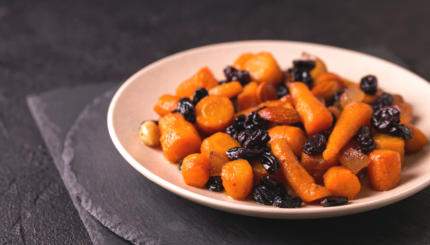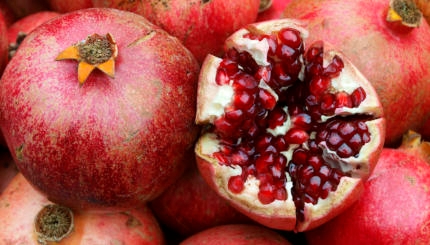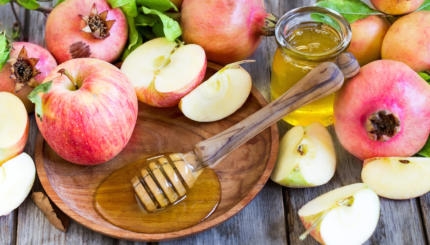On the first and second nights of Rosh Hashanah, most Jewish families gather for a festive and elaborate dinner. Before eating the actual meal, Sephardic and Mizrahi Jews partake in a longstanding custom: the Rosh Hashanah seder.
The word seder is Hebrew for “order” and is a reference to the specific order that the blessings and readings follow each year. Blessings are recited in a specific order over simanim, or symbolic foods. The seder also includes festive songs, biblical readings and the recitation of piyyutim (liturgical poems). Like any other Jewish ritual, the melodies, foods and traditions can vary among different communities and families.
It is unclear when Rosh Hashanah seders became commonplace, but the practice of eating symbolic foods was already a custom by talmudic times. During a discussion about omens in Tractate Horayot 12a, the sage Abaye said:
A person should always be accustomed to seeing these on Rosh Hashanah: Squash, and fenugreek, leeks, and chard, and dates, as each of these grows quickly and serves as a positive omen for one’s actions during the coming year.
Some families arrange the foods on a seder plate, like one would do during Passover. Others incorporate each food into a separate dish that is then served during the meal, such as bean soup or stuffed dates.
With your help, My Jewish Learning can provide endless opportunities for learning, connection and discovery.
Click here for recipes and more details about foods used in the seder.
There is no authoritative text for the Rosh Hashanah seder. Different communities use different lists and arrange the foods in different orders. Some families also enjoy creating their own symbols and puns in any language — for example, some English-speaking families say “Lettuce have a good year!” over a head of lettuce.
Lighting Rosh Hashanah Candles and Reciting Shehechiyanu
Like other Rosh Hashanah celebrations, the seder begins with lighting candles, reciting the holiday candle blessing and then saying Shehechiyanu.
בָּרוּךְ אַתָּה ה’ אֱלֹהֵֽינוּ מֶֽלֶךְ הָעוֹלָם אֲשֶׁר קִדְּשָֽׁנוּ בְּמִצְוֹתָיו וְצִוָּֽנוּ לְהַדְלִיק נֵר שֶׁל (שַׁבָּא וְ-) יוֹם טוֹב
Baruch ata Adonai, Eloheinu Melech ha-olam, asher kidshanu b’mitzvotav vitzivanu l’hadlik ner shel (Shabbat and) yom tov.

Blessed are You, Adonai, our God, King of the Universe, Who sanctified us with His commandments, and commanded us to kindle the (Shabbat and) Yom Tov light.
בָּרוּךְ אַתָּה ה’ אֱלֹהֵֽינוּ מֶֽלֶךְ הָעוֹלָם שֶׁהֶחֱיָֽנוּ וְקִיְּמָֽנוּ וְהִגִּיעָֽנוּ לַזְמַן הַזֶּה
Baruch ata Adonai elohenu melekh ha’olam, shehecheyanu, v’kiyimanu, v’higiyanu la’z’man ha’zeh.
Blessed are You, Adonai, our God, King of the Universe, who has sustained us and brought us to this season.
Rosh Hashanah Kiddush
Next, one sanctifies the holiday by reciting the special Kiddush (blessing over wine) for Rosh Hashanah.
Find the full text of the Rosh Hashanah Kiddush on Sefaria.
If Rosh Hashanah begins on a Saturday evening, Havdalah is recited after Kiddush.
The Simanim: Symbolic Foods for Rosh Hashanah
The exact order of the simanim during the seder varies between communities. The exact foods eaten can also vary — for example, Jews from Libya mix sugar and sesame seeds instead of using fenugreek or string beans, according to Jewish writer Rahel Musleah.
Each blessing over the simanim begins with Yehi ratzon milfanecha Hashem eloheinu v’elohei avoteinu: “May it be Your will, God and God of our ancestors.” This is followed by a hope for something that will happen in the new year.
Dates: The Hebrew word for dates, tamar, resembles the word for end, yitamu. Dates represent our desire for our enemies to end their hateful conquests.
יְהִי רָצוֹן מִלְּפָנֶיךָ ה’ אֱלֹהינוּ וֵאלֵֹהי אֲבוֹתֵינוּ (וְאִמוֹתֵינוּ), שֶׁיִּתַּמּוּ אוֹיְבֵינוּ וְשׂוֹנְאֵינוּ וְכָל מְבַקְשֵׁי רָעָתֵנוּ
Yehi ratzon milfanecha Adonai eloheinu v’elohei avoteinu (v’imoteinu) she’yitamu oyveinu v’soneinu v’chol m’vaskshei ra’ateinu.
May it be Your will, God and the God of our ancestors, that there will be an end to our enemies, haters and those who wish evil upon us.

String beans, fenugreek or beans: The Aramaic word for fenugreek, rubia, is similar to the Hebrew word yirbu, increase.
יְהִי רָצוֹן מִלְּפָנֶיךָ ה’ אֱלֹהינוּ וֵאלֵֹהי אֲבוֹתֵינוּ (וְאִמוֹתֵינוּ), שֶׁיִּרְבּוּ זְכֻיוֹתֵינוּ
Yehi ratzon milfanecha Adonai eloheinu v’elohei avoteinu (v’imoteinu) she’yirbu zakiyoteinu u’t’leivavenu.
May it be Your will, God and the God of our ancestors, that our merits shall increase and that You hearten us.

Leeks: In Aramaic, leeks are called karti; the Hebrew term for cutting off is karet. Leeks represent our hopes that our enemies will be “cut off.”
יְהִי רָצוֹן מִלְּפָנֶיךָ ה’ אֱלֹהינוּ וֵאלֵֹהי אֲבוֹתֵינוּ (וְאִמוֹתֵינוּ), שֶׁיִּכָּרְתוּ אוֹיְבֵינוּ וְשׂוֹנְאֵינוּ וְכָל מְבַקְשֵׁי רָעָתֵנוּ
Yehi ratzon milfanecha Adonai eloheinu v’elohei avoteinu (v’imoteinu), she’yikartu oyveinu v’soneinu v’kol m’vakshei ra’ateinu.
May it be Your will, God and the God of our ancestors, that our enemies, haters, and those who wish evil upon us shall be cut off.

Swiss chard or beets: Selek is the term for beets in both Hebrew and Aramaic, and it sounds like silek, or “depart.”
יְהִי רָצוֹן מִלְּפָנֶיךָ ה’ אֱלֹהינוּ וֵאלֵֹהי אֲבוֹתֵינוּ (וְאִמוֹתֵינוּ), שֶׁיִּסְתַּלְּקוּ אוֹיְבֵינוּ וְשׂוֹנְאֵינוּ וְכָל מְבַקְשֵׁי רָעָתֵנוּ
Yehi ratzon milfanecha Adonai eloheinu v’elohei avoteinu (v’imoteinu), she’yistalku oyveinu v’soneinu v’kol m’vakshei ra’ateinu.
May it be Your will, God and the God of our ancestors, that our enemies, haters and those who wish evil upon us shall depart.

Squash or gourd: The Aramaic word k’ra is reminiscent of the Hebrew words kriah (to tear) and kara (to proclaim/announce). The blessing recited before eating squash or gourd at the seder reflects this dual connection.
יְהִי רָצוֹן מִלְּפָנֶיךָ ה’ אֱלֹהינוּ וֵאלֵֹהי אֲבוֹתֵינוּ (וְאִמוֹתֵינוּ), שֶׁתִּקְרַע רוֹעַ גְּזַר דִּינֵנוּ, וְיִקָּרְאוּ לְפָנֶיךָ זְכֻיוֹתֵינוּ
Yehi ratzon milfanecha Adonai eloheinu v’elohei avoteinu (v’imoteinu), she’tikra ro’ah gezeira dineinu, v’yikaru l’fanecha zakiyoteinu.
May it be Your will, God and the God of our ancestors, that the evil of our verdicts be ripped up, and that our merits be announced before you.

Pomegranate: In addition to being one of the seven species of Israel, pomegranates have a long history of being symbolic in Judaism. At the Rosh Hashanah seder, their many seeds represent the 613 mitzvot. The seeds can also symbolize the many blessings that we hope will manifest in the coming year.
יְהִי רָצוֹן מִלְּפָנֶיךָ ה’ אֱלֹהינוּ וֵאלֵֹהי אֲבוֹתֵינוּ (וְאִמוֹתֵינוּ), שֶׁנִּהְיֶה מְלֵאִים מִצְוֹת כָּרִמּוֹן
Yehi ratzon milfanecha Adonai eloheinu v’elohei avoteinu (v’imoteinu), she’nihiyeh m’lei’im mitzvot ka’rimon.
May it be Your will, God and the God of our ancestors, that we be filled with mitzvot like a pomegranate (is filled with seeds).

Apples dipped in honey: Apples eaten with honey represent our hopes for a sweet new year.
יְהִי רָצוֹן מִלְּפָנֶיךָ ה’ אֱלֹהינוּ וֵאלֵֹהי אֲבוֹתֵינוּ (וְאִמוֹתֵינוּ), שֶׁתְּחַדֵּשׁ עָלֵינוּ שָׁנָה טוֹבָה וּמְתוּקָה כַּדְּבָשׁ
Yehi ratzon milfanecha Adonai eloheinu v’elohei avoteinu (v’imoteinu), she’t’chadesh aleinu shanah tovah u’metukah ka’devash.
May it be Your will, God and the God of our ancestors, that You renew for us a year that is good and sweet like honey.

Fish or sheep head: Rosh Hashanah literally translates as “head of the year,” which is reflected by putting a literal head on the table. The type of head varies; a fish head alludes to Deuteronomy 28:13, which says that God will make Moses “the head and not the tail.” Others put a sheep’s head on the table to symbolize the ram that spared Isaac in the Akedah, a biblical story that we read on the second day of Rosh Hashanah. In modern times, vegetarians often use a head of lettuce or cauliflower.
יְהִי רָצוֹן מִלְּפָנֶיךָ ה’ אֱלֹהינוּ וֵאלֵֹהי אֲבוֹתֵינוּ (וְאִמוֹתֵינוּ), שֶׁנִּהְיֶה לְרֹאשׁ וְלֹא לְזָנָב
Yehi ratzon milfanecha Adonai eloheinu v’elohei avoteinu (v’imoteinu), she’nihiyeh l’rosh v’lo zanav.
May it be Your will, God and the God of our ancestors, that we be like a head and not a tail.
Other Components of the Rosh Hashanah Seder
Following the simanim, seder participants ritually wash their hands and recite Netilat Yadayim:
בָּרוּךְ אַתָּה ה׳ אֱלֹהֵינוּ מֶלֶךְ הָעוֹלָם אֲשֶׁר קִדְּשָׁנוּ בְּמִצְוֹתָיו וְצִוָּנוּ עַל נְטִילַת יָדַיִם
Baruch ata Adonai, Eloheinu Melech ha-olam, asher kidshanu b’mitzvotav vitzivanu al n’tilat yadayim.
Blessed are You, Lord our God, King of the universe, who has sanctified us with Your commandments, and commanded us concerning the washing of the hands.

Hamotzi, the blessing over the bread, is recited once everyone at the table has washed their hands. The text of the Hamotzi on Rosh Hashanah is exactly the same as the text on Shabbat:
בָּרוּך אַתָּה ה׳ אֱלֹהֵינוּ מֶלֶך הָעוֹלָם הַמּוֹצִיא לֶחֶם מִן הָאָרֶץ
Blessed are You, Lord our God, King of the universe, who has brought forth bread from the earth.
Baruch ata Adonai, Eloheinu Melech ha-olam, hamotzi lechem min ha’aretz.

It is customary on Rosh Hashanah to make the blessing over round loaves, symbolizing the circle of life and the revolving seasons.
The incorporation of songs, piyyutim (liturgical poems) and biblical readings varies from seder to seder. Rahel Musleah’s “Apples and Pomegranates: A Rosh Hashanah Seder” includes options for family-friendly Rosh Hashanah seder additions.
Rosh Hashanah
Pronounced: roshe hah-SHAH-nah, also roshe ha-shah-NAH, Origin: Hebrew, the Jewish new year.
seder
Pronounced: SAY-der, Origin: Hebrew, literally "order"; usually used to describe the ceremonial meal and telling of the Passover story on the first two nights of Passover. (In Israel, Jews have a seder only on the first night of Passover.)
Sephardic
Pronounced: seh-FAR-dik, Origin: Hebrew, describing Jews descending from the Jews of Spain.
shiva
Pronounced: SHI-vuh (short i), Origin: Hebrew, seven days of mourning after a funeral, when the mourner stays at home and observes various rituals.
hamotzi
Pronounced: ha-MOE-tzee, Origin: Hebrew, blessing said over bread. On Shabbat Hamotzi is usually said over challah.



